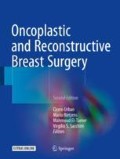Abstract
Although rupture is one of the main causes of implant removal, its real rate is difficult to quantify, especially in breast reconstruction. Most of the ruptures have no obvious traumatic origin and are silent or intracapsular, thus asymptomatic, and with a difficult diagnosis with conventional exams (mammogram and ultrasound). Magnetic resonance imaging is the most accurate method for implant failure diagnosis, but long-term cohort studies are necessary to evaluate integrity rates of these devices to better support their indications, follow-up, and limits in breast reconstruction. The aim of this chapter was to address the incidence, evaluation, and management of implant rupture in breast reconstruction.
Access this chapter
Tax calculation will be finalised at checkout
Purchases are for personal use only
References
Shestak KC (ed) (2006) Reoperative plastic surgery of the breast. Lippincott Williams & Wilkins, Philadelphia
Lotan AM, Retchkiman M, Tuchman I et al (2016) Analysis of 109 consecutive explanted breast implants: correlation between suspected implant rupture and surgical findings. Aesthet Plast Surg 40:739–744
Handel N, Garcia ME, Wixtrom R (2013) Breast implant rupture: causes, incidence, clinical impact, and management. Plast Reconstr Surg 132(5):1128–1137
Rella L, Telegrafo M, Nardone A et al (2015) MRI evaluation of post-mastectomy irradiated breast implants: prevalence and analysis of complications. Clin Radiol 70:948–953
Hölmich LR, Vejborg IM, Conrad C et al (2004) Untreated silicone breast implant rupture. Plast Reconstr Surg 114(1):204–214
Juanpere S, Perez E, Huc O et al (2011) Imaging breast implants—a pictorial review. Insights Imaging 2(6):653–670
Hernandes MJG, Milena GL, Carazo ER (2016) Subacute silicone pneumonitis after silent rupture of breast implant. Arch Bronconeumol 52(7):397–398
Oh JH, Song SY, Lew DH et al (2016) Distant migration of multiple siliconomas in lower extremities following breast implant rupture: case report. Plast Reconstr Surg Glob Open 4:e1011
Lee BT, Duggan MM, Keenan MT et al (2011) Commonwealth of Massachusetts Board of Registration in medicine expert panel on immediate implant-based breast reconstruction following mastectomy for cancer: executive summary, June 2011. J Am Coll Surg 213(6):800–805
Brown MH, Shenker R, Silver SA (2005) Cohesive silicone gel breast implants in aesthetic and reconstructive breast surgery. Plast Reconstr Surg 116:768–779
Heneghan C (2012) The saga of Poly Implant Prosthèse breast implants. BMJ 344:e306
Nathan B, Meleagros L, Mashhadi S et al (2015) The breast implant rupture warranty: what is it really worth? Aesthet Plast Surg 39:826
Hedén P, Nava MB, van Tetering JPB et al (2006) Prevalence of rupture in Inamed silicone breast implants. Plast Reconstr Surg 118:303–308
Haws MJ, Alizadeh K, Kaufaman DL (2015) Sientra primary and revision augmentation rupture trending and analysis with magnetic resonance imaging. Aesthet Surg J 35(S1):S33–S42
Hölmich LR, Friis S, Fryzek JP et al (2003) Incidence of silicone breast implant rupture. Arch Surg 138:801–806
McLaughlin JK, Lipworth L, Murphy DK, Walker PS (2007) The safety of silicone gel-filled breast implants. Ann Plast Surg 59:569–580
Puskas JE, Luebbers MT (2012) Breast implants: the good, the bad and the ugly. Can nanotechnology improve implants? WIREs Nanomed Natobiotechnol 4:153–168. https://doi.org/10.1002/wnan.164
Marotta JS, Goldberg EP, Habal MB et al (2002) Silicone gel breast implant failure: evaluation of properties of shells and gels for explanted prostheses and meta-analyses of literature rupture data. Ann Plast Surg 49:227–242
Slavin SA, Goldwyn RM (1995) Silicone gel implant explantation: reasons, results and admonitions. Plast Reconstr Surg 95:63–66
Henriksen TF, Frysek JP, Hölmich LB et al (2005) Reconstructive breast implantation after mastectomy for breast cancer. Arch Surg 140:1152–1159
Rochira D, Cavalcanti P, Ottaviani A et al (2016) Longitudinal ultrasound study of breast implant rupture over a six-year interval. Ann Plast Surg 76(2):150–154
Venta LA, Salomon CG, Flisak ME, Venta ER, Izquierdo R, Angelats J (1996) Sonographic signs of breast implant rupture. Am J Roentgeno 166:1413–1419
Monticciolo DL, Nelson RC, Dixon WT, Bostwick III, Mukudan S, Hester TR (1994) MR detection of leakage from silicone breast implants: value of a silicone-selective pulse sequence. AJR 163:51–56
Gorczyca DP, Gorczyca SM, Gorczyca KL (2007) The diagnosis of silicone breast implant rupture. Plast Reconstr Surg 120:49S–61S
Seiler SJ, Sharma PB, Hayes JC et al (2017) Multimodality imagingbased evaluation of singlelumen silicone breast implants for rupture. Radiographics 37(2):366–382
Rietjens M, Villa G, Toesca A et al (2014) Appropriate use of magnetic resonance imaging and ultrasound to detect early silicone gel breast implant rupture in postmastectomy reconstruction. Plast Reconstr Surg 134:13e–20e
Nahabedian MY (2014) Discussion: appropriate use of magnetic resonance imaging and ultrasound to detect early silicone gel breast implant rupture in postmastectomy reconstruction. Plast Reconstr Surg 134:21e–23e
Glazebrook KN, Leng S, Jacobson SR et al (2016) Dual-energy CT for evaluation of intra- and extracapsular silicone implant rupture. Case Rep Radiol 2016:6323709 4 pages
Author information
Authors and Affiliations
Editor information
Editors and Affiliations
Rights and permissions
Copyright information
© 2019 Springer International Publishing AG, part of Springer Nature
About this chapter
Cite this chapter
Urban, C., Resende, M., Mansani, F.P., Rietjens, M. (2019). Implant Rupture. In: Urban, C., Rietjens, M., El-Tamer, M., Sacchini, V.S. (eds) Oncoplastic and Reconstructive Breast Surgery. Springer, Cham. https://doi.org/10.1007/978-3-319-62927-8_49
Download citation
DOI: https://doi.org/10.1007/978-3-319-62927-8_49
Published:
Publisher Name: Springer, Cham
Print ISBN: 978-3-319-62925-4
Online ISBN: 978-3-319-62927-8
eBook Packages: MedicineMedicine (R0)

